McKee's 37 BEAST Compound & McKee's 37 FINISHER Polish!

Abrasive Technology - The MOST important factor when it comes to polishing anything!
I always hate to say this but it provides much needed context, so here goes...
I've been detailing cars since the 1970s. Probably longer than some of you reading this have been alive. And the BIG PICTURE point I'm trying to make with you, my reader is over the course of the last 50 years, I've used a LOT of different compounds, polishes and cleaner/waxes. It is these three categories of products that use some form of abrasive technology.
- Compounds
- Polishes
- Cleaner/Waxes or AIOs, which stands for All-in-Ones
Removing defects means removing a little paint
When it comes to removing things like,
- Swirls
- Scratches
- Water spots
- Oxidation
The way you remove these out of the finish on your car is you abrade the surface with either a compound, polish or cleaner/was and by doing so, you remove a little paint. Using a product from any of these three categories to remove defects and perfect the finish is called paint correction.
Paint correction LEVELS the surface by abrading the upper most top surface until it is level with the lowest depths of the defect you're trying to remove. Sounds simple enough but there's problem.
Not all abrasive technology is great stuff
When it comes to abrasive technology, there's really only two groups.
- Great abrasive technology
- Junk abrasive technology
Unlike a lot of things in life, there is no gray area.
Here's why...
Great abrasive technology has the ability to remove defects without leaving its own defect behind in the paint. If a compound, polish or cleaner/wax removes defects like swirls and scratches BUT leaves it's own set of marks or in reality - scratches behind in the paint, it's junk science or junk abrasive technology.
Paint is thin
The factory clearcoat on modern cars is thinner than a Post-It Note. A Post-It Note is around 3 mils thin. The factory clearcoat is around 2 mils thin. Next time you see a Post-It Note, hold it between your thumb and index finger and it's pretty easy to wrap your brain around just how thing the factory layer of clearcoat paint is on a modern car.
When it comes to removing swirls and scratches out of your car's finish you really want to do it right the first time. The last thing you want to do is polish-out your car only to find out it looks funny? When people contact me and tell me the paint on their car looks better after they polished it but there's something not quite right - the first thing I do is ask them,
What are you using for a compound, polish or cleaner/wax?
And 9 out of 10 times, the problem is the product or more specifically, the abrasive technology. Yeah I know, it's the year 2023 and by now, shouldn't everything on the market be great? You would think so or better, you would hope so. But as a guy that details cars professional, teaches car and boat detailing classes, has authored 7 books on the top of car and boat detailing and hosted 2 TV shows, I'm here to tell you... there's still junk on the market.
How can you know the good from the bad?
Great question and it's not easy to always know or be able to tell the great from the junk. One thing I can tell you, I only use products that also use great abrasive technology. I never use junk. I work on a lot of cool cars, I write a lot of articles, I make a lot of videos and I teach a lot of people how to polish paint and I would never use or show someone else how to use anything I personally wouldn't use on my own cars, on black cars or showcase in a class.
So if you've seen me use a product in any type of educational work, you can trust this product uses great abrasive technology. If there's ever a product you have not seen me use, then I ether haven't gotten to it yet, I don't know about it, (could be new to the market), or I have used it, (tested it), and it failed my testing procedures for abrasive technology.
Here's the good news!
McKee's 37 BEAST Compound and FINISHER Polish passed all the tests because they use great abrasive technology and you can take that to the bank! Both of these product have the ability to remove defects without leaving their own defects behind. And to prove it, I used a BLACK, totally swirled-out 1968 Chevrolet Chevelle Convertible muscle car to showcase their abilities.
Before Condition
Here's how the car looked when it first arrived to AutoForge.net - looks good under diffused lights as diffused lights don't work well to reveal the true and accurate condition of the paint. I'll move it outside where the sun is shining brightly and then you'll really see the true condition of the paint.
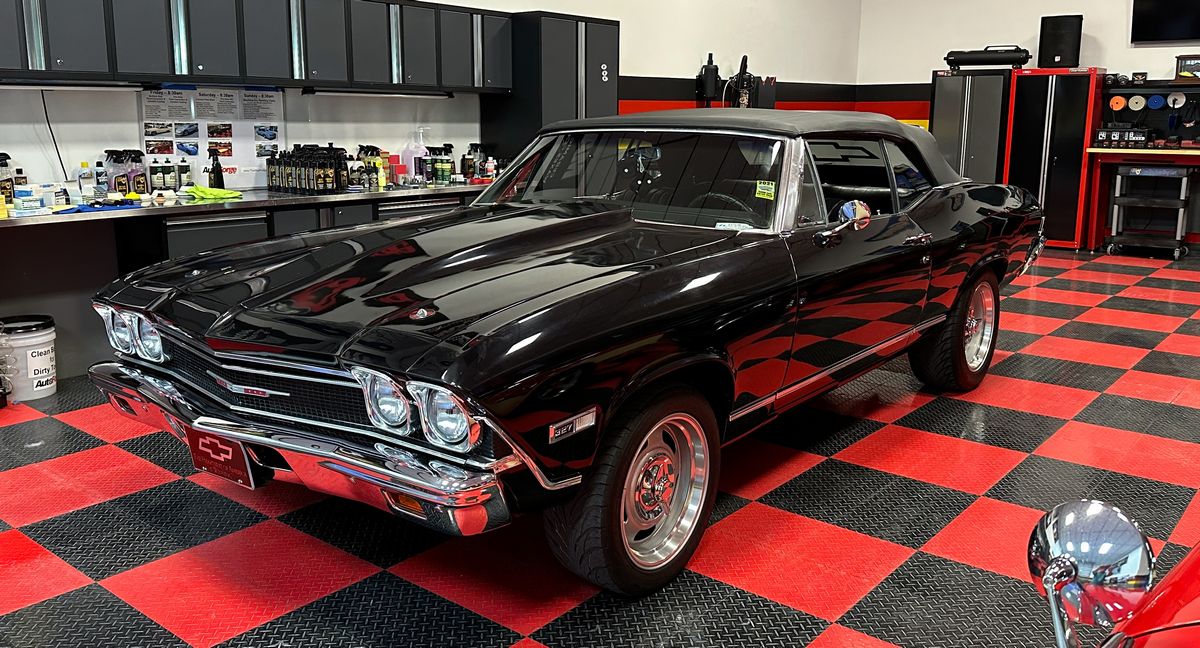
Here's what she looks like outside in full overhead sunlight around noon

Hologram scratches from a wool pad used on a rotary polisher
Nasty huh? What you see in the pictures are HOLOGRAMS, which are the scratch pattern instilled into the paint when you ONLY buff with a wool pad on a rotary polisher. The fibers that make-up the wool pad CUT the paint and leave behind a pattern of holographic looking lines in the paint. The circular swirls are are also caused by the fibers of the wool pad but it's the patterns you see that are the actual holograms.
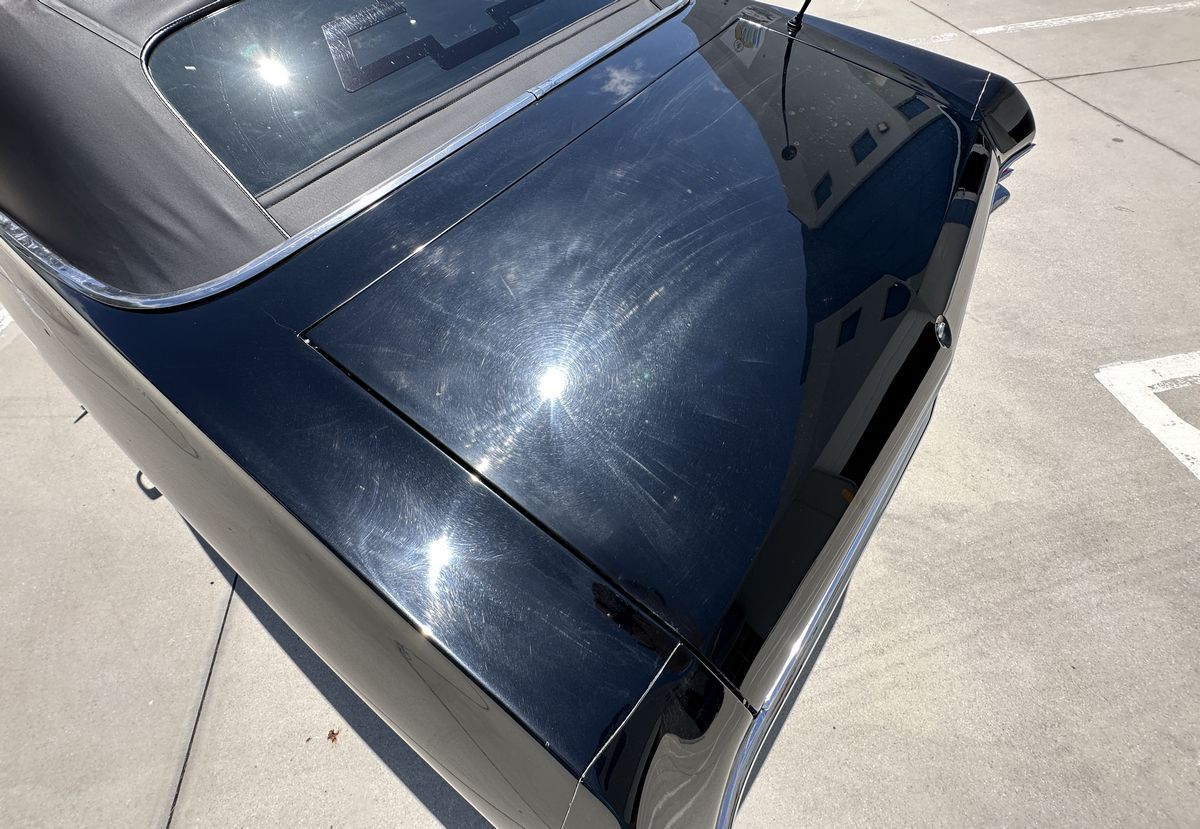
Pretty bad huh? In fact, you would be hard pressed to find a car anywhere in this bad of shape. No problem if you have great abrasive technology and have buffed out a few cars like this before and I have.
Process
For this process, I did to test sections. One with my buddy Nick Rutter where all we did was compound a section of the hood and then polish. For the other test, I machine dry sanded the paint first to remove the tracers and deep holograms, and then I used the BEAST Compound with a wool pad to remove the sanding marks and the FINISHER polish to maximize gloss and clarity.
Before & After Video
You can watch a short video that shows me using the compound first followed by Nick using the polish.
Before & After Pictures
Here's some before and after pictures from the demonstration performed on the Chevelle using the BEAST Compound and the FINISHER Polish.
BEFORE

AFTER

Training and Testing Car
Besides using this car to showcase the abilities of the new McKee's 37 Beast Compound and FINISHER Polish, this car was also here for me to make a video on how to use the Eagle Abrasives by Kovax Machine Dry Sanding System, which we showcase in our 3-day car detailing classes and will have on the AutoForge.net store site.
We also used this car for a training and testing car for a special project with some Engineers from FLEX Power Tools who traveled here from Germany to spend a day using all types of polishers on this 1968 Chevelle. So one car, lots of great new educational content.
Process
In the below photos, you'll see me using the McKee's 37 Beast Compound with a 7.5 Inch Redline 100% Twisted Wool Cutting Pad on the FLEX PE-150 Rotary Polisher, (my favorite cordless too and favorite rotary polisher overall), followed by machine polishing using McKee's 37 FINISHER Polish with a Redline 6.75 Orange Foam Polishing Pad on the FLEX XC 3401 VRG Dual Action Orbital Polisher also known as THE BEAST!
As you read through the below pictures, I'll share some tips and techniques for using the BEAST and the FINISHER!
Clean your pad often!
Anytime you're using a compound with a wool pad on a rotary polisher you need to clean your pad often. To do this, use the Redline Wool Pad Cleaning Spur. Cleaning your pad often removes the paint you've abraded off the surface and spend compound residue. Cleaning the pad often enables the compound to work faster and more effectively while reducing dust and making the residue easier to remove.

Lay down a strip or bead of compound about the size and length of a pencil
When using a full size wool pad, in this case the McKee's 37 Redline 7.5" Wool Cutting Pad, you want to use the amount of product you see me placing on the hood. For reference, it should look like the width and length of a pencil.
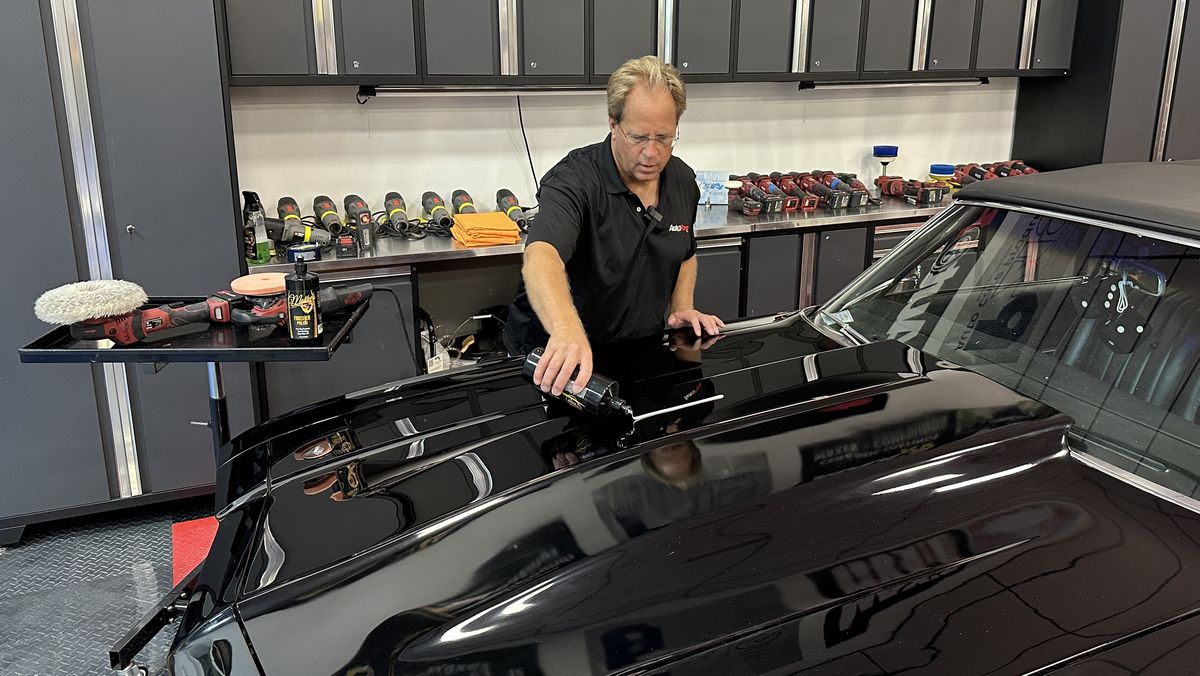

The 10 @ 10 Technique
Use the 10 @ 10 Technique to pick up the strip of product without splattering it all over the place. This is a technique we share in all our car and boat detailing classes. Besides working cleaner and avoiding wasting any product - you look like a seasoned professional.

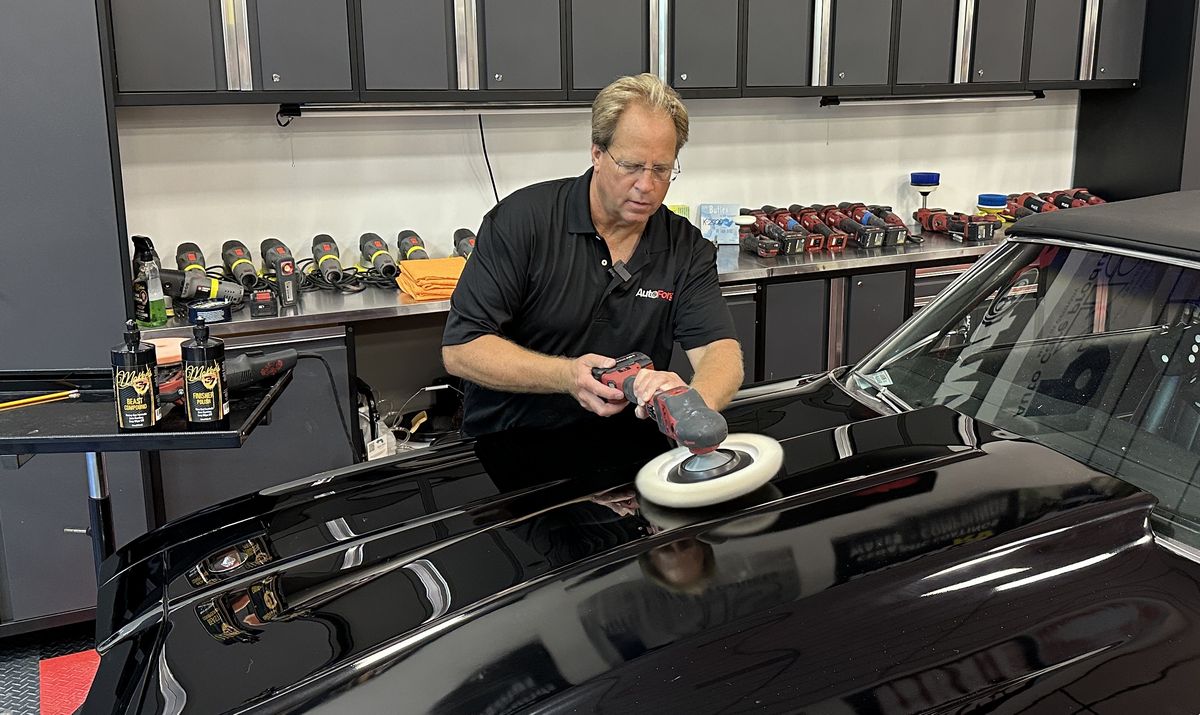
After you pick up the strip of compound, spread the compound over the surface to be worked and then work the panel.

Going up on edge
There are two schools of though on how to correctly hold and use a wool pad on a rotary polisher.
One school of thought is to [try] to hold the pad flat as you buff a panel. This works when you first start out and the pad is still dry. As the pad becomes wet with product the pad will start to grab the paint as you buff and next the pad will yank you all over the place. This not only makes for ineffective buffing but it will also tire you out.
The second school of thought, which is also the way I teach, preach and use the polisher myself, is to go up on edge like you see me holding the polisher in the below pictures. Try both techniques and I'm confident as you work around a car or boat, you'll see why I practice and teach in our car and boat detailing classes - how to go up on edge.

My favorite rotary polisher
The FLEX PE-150 Cordless Rotary Polisher. So much power. Super quiet compared to less expensive brands and incredibly lightweight - about 5 pounds. And best of all - no cord!
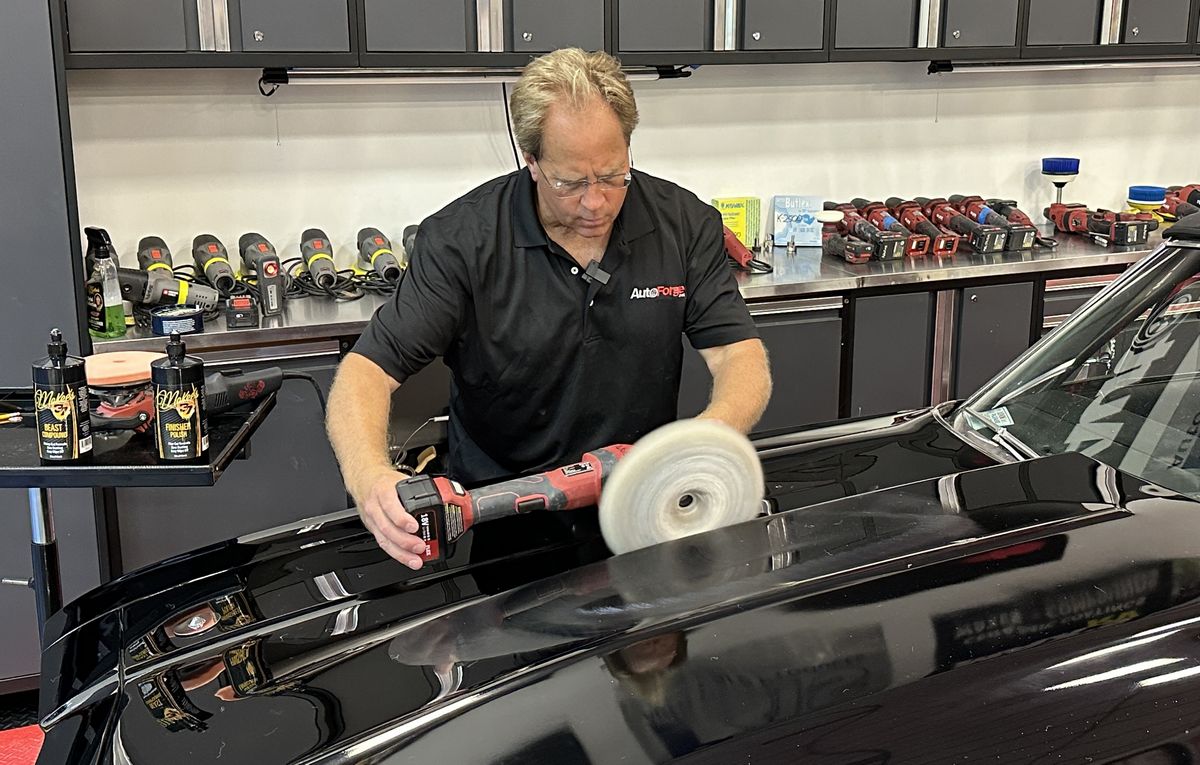
Quality Microfiber Towels
Anytime you're doing paint correction, you need high quality, clean uncontaminated microfiber towels. At this time, the towel I like best and we use in all our car and boat detailing classes is the Orange Brushed Edgeless 365 Premium Microfiber Terry Towels.
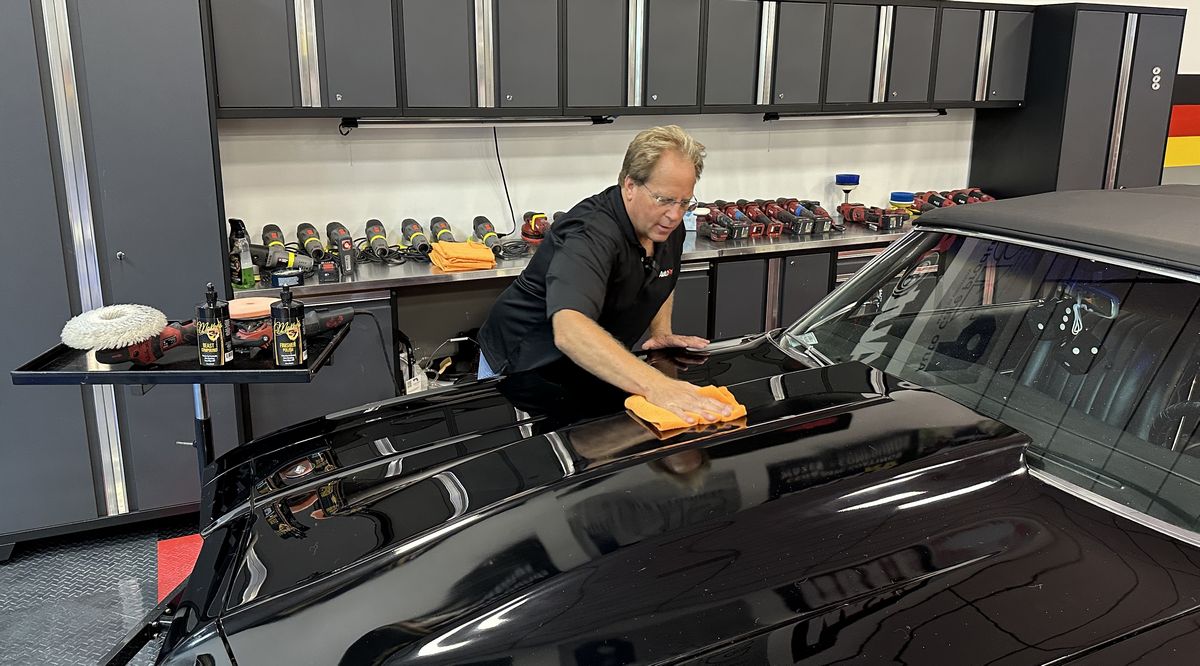
Machine polishing
After compounding, to really maximize the gloss and clarity as well as prepare the paint for the LSP or Last Step Product, (usually a wax, paint sealant or ceramic coating), you want to re-polish the paint using the McKee's 37 FINISHER Polish with a foam polishing pad like the Redline 6.75" Orange Foam Polishing Pad. The tool you see me using is the FLEX XC 3401 VRG also known as The BEAST. This is a n 8mm gear-driven orbital polisher. It has a LOT of power and because it's gear-driven - there's ZERO PAD STALLING and thus ZERO WASTED TIME.
It's important to always center your buffing pads onto the backing plate. To help me get it perfect, I rest my thumb against the edge of the backing plate as I bring the pad closer and closer to the backing plate. A simple technique that works great.


Apply product to the face of the pad
After you center the pad, apply 3 to 4 Pea Sized drops of polish to the face of the pad. Then place the face of the pad against the paint before turning the polisher on. After you turn the polisher on, spread the product out over the area to be polished and then start making slow overlapping pass in a crosshatch pattern.

Pro Tip
Always place the power cord over your shoulder when using a corded tool so you don't drag the cord against the paint.

Zero dusting - long buffing cycle or "open time"
Everyone hates a polish that dries up quickly as you work it and then creates dust all over the car. The McKee's 37 FINISHER Polish has a super long open time with zero dusting. This is a fast correcting polish that finishes out with perfect gloss and clarity and zero micro-marring like some polishes on the market today.

Easy wipe-off
This is just as important as the performance of the polish itself. If a polish is difficult or sticky to wipe-off, you risk putting scratches back into the paint that you just polished to perfection. One tip I practice and share is always wipe a compound and a polish off IMMEDIATELY after buffing a section. The polishing oils used in the compound and the polish will still be wet on the surface and actually lubricate the wipe-off process.

Here's the final results...
BEFORE

AFTER

My comments...
This iconic muscle car came to the AutoForge.net Garage a swirled-out mess but it's going to leave here looking like a black diamond with a liquid wet looking finish, as though it just came out of the paint booth.
The new McKee's 37 BEAST Compound completely eliminated the swirls, scratches, sanding marks and all other below surface paint defects.
The McKee's 37 FINISHER Polish maximized the gloss, clarity and shine to perfectly prepare the paint for the final step.
Abrasive Technology you can trust
If I show it - it's great. If I use it, especially on a black car, it's great. And when I bring these kinds of products into a classroom, you can trust these product use great abrasive technology. I taught my first detailing class in 1987, and since then I never show or use products that I would not use myself on my own cars, class training cars or my client's cars.
From the AutoForge.net website
McKee’s 37 BEAST Compound
Our flagship polishing compound destroys swirl marks and scratches!
McKee’s 37 BEAST Compound features the most advanced abrasive technology available in any body-shop safe compound. Formulated to remove 1000 grit or finer sanding scratches, McKee’s 37 BEAST Compound makes quick work of paint defects including swirl marks, water spots, and scratches. Unlike other aggressive compounds, McKee’s 37 BEAST Compound will not scour or haze the finish. This saves you time and effort in the polishing process. McKee’s 37 BEAST Compound does not dust or smear, and it wipes off without any effort. Safe for all paint systems including clear coat and single stage.
McKee’s 37 BEAST Compound utilizes the most advanced abrasive technology available. The abrasive technology is what allows BEAST Compound to remove heavy paint defects without scouring the finish. The abrasive powder in BEAST Compound is so fine that the product feels like a skin lotion, instead of a gritty compound. But don't let that fool you: BEAST Compound cuts fast and annihilates all paint defects!
McKee’s 37 BEAST Compound can be used after sanding to remove sanding marks, or by itself to remove deeper swirl marks, water spots, and scratches. Regardless of your application, you'll be delighted at how easily BEAST Compound wipes off, plus it doesn't dust!
McKee’s 37 BEAST Compound is body-shop safe and VOC compliant. Those with sensitive noses will be pleased to hear that BEAST Compound does not have a volatile odor! The lack of a strong, pungent odor, is a testament to the high-quality formula.
McKee’s 37 FINISHER Polish
Create a dazzling show-car shine!
McKee’s 37 FINISHER Polish is designed to be used after McKee’s 37 BEAST Compound to maximize gloss and surface smoothness, or as a stand-alone polish on vehicles that are new or well-maintained. The micro abrasives in FINISHER Polish work to remove hazing and minor paint imperfections, creating a show-car finish. McKee’s 37 FINISHER Polish can be applied by hand or machine. The level of cut is dependent on the aggressiveness of the pad you’re using to apply it.
McKee’s 37 FINISHER Polish utilizes the most advanced abrasive technology available. The abrasive technology is what allows FINISHER Polish to create unrivaled levels of gloss, especially on darker colors. McKee’s 37 FINISHER Polish can be used after compounding to remove holograms, or by itself to remove shallow swirl marks, water spots, and light scratches. Regardless of your application, you'll be delighted at how easily FINISHER Polish wipes off, plus it doesn't dust!
McKee’s 37 FINISHER Polish is body-shop safe and VOC compliant. Those with sensitive noses will be pleased to hear that Finisher Polish does not have a volatile odor, in fact it doesn't smell like anything! The smell, or lack thereof, is a testament to the high-quality formula. FINISHER Polish does not have fillers, and can be applied by hand or with a rotary or dual action polisher.
On AutoForge.net
McKee's 37 Beast Compound - Available in 8 ounce and 32 ounce bottles
McKee's 37 FINISHER Polish - Available in 8 ounce and 32 ounce bottles
7.5 Inch Redline 100% Twisted Wool Cutting Pad
FLEX PE-150 Rotary Polisher
Redline 6.75 Orange Foam Polishing Pad
FLEX XC 3401 VRG Dual Action Orbital Polisher aka THE BEAST!
Eagle Abrasives by Kovax Machine Dry Sanding System
Redline Wool Pad Cleaning Spur
Orange Brushed Edgeless 365 Premium Microfiber Terry Towels
Stay tuned for the final chapter for this 1968 Chevelle!.
Wax? Sealant? Or Ceramic Coating?Stay tuned to see how I finish out this 1968 Chevelle. Will it be a wax? A paint sealant? Or a ceramic coating? The LSP Reveal - Next week!
Questions?
Shoot me an email, I'm always happy to answer questions and talk about car and boat detailing.
Mike Phillips
Mike@AutoForge.net

